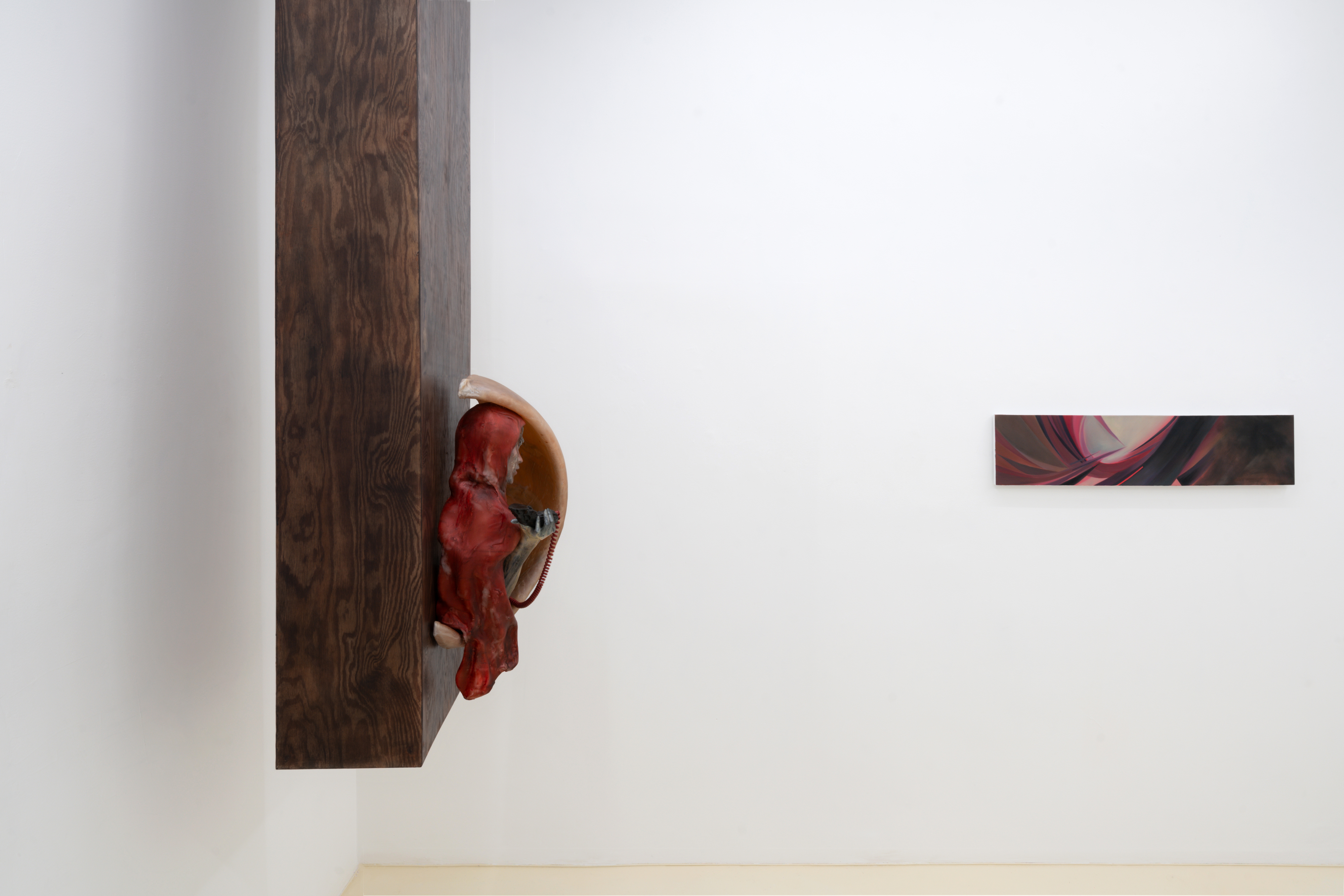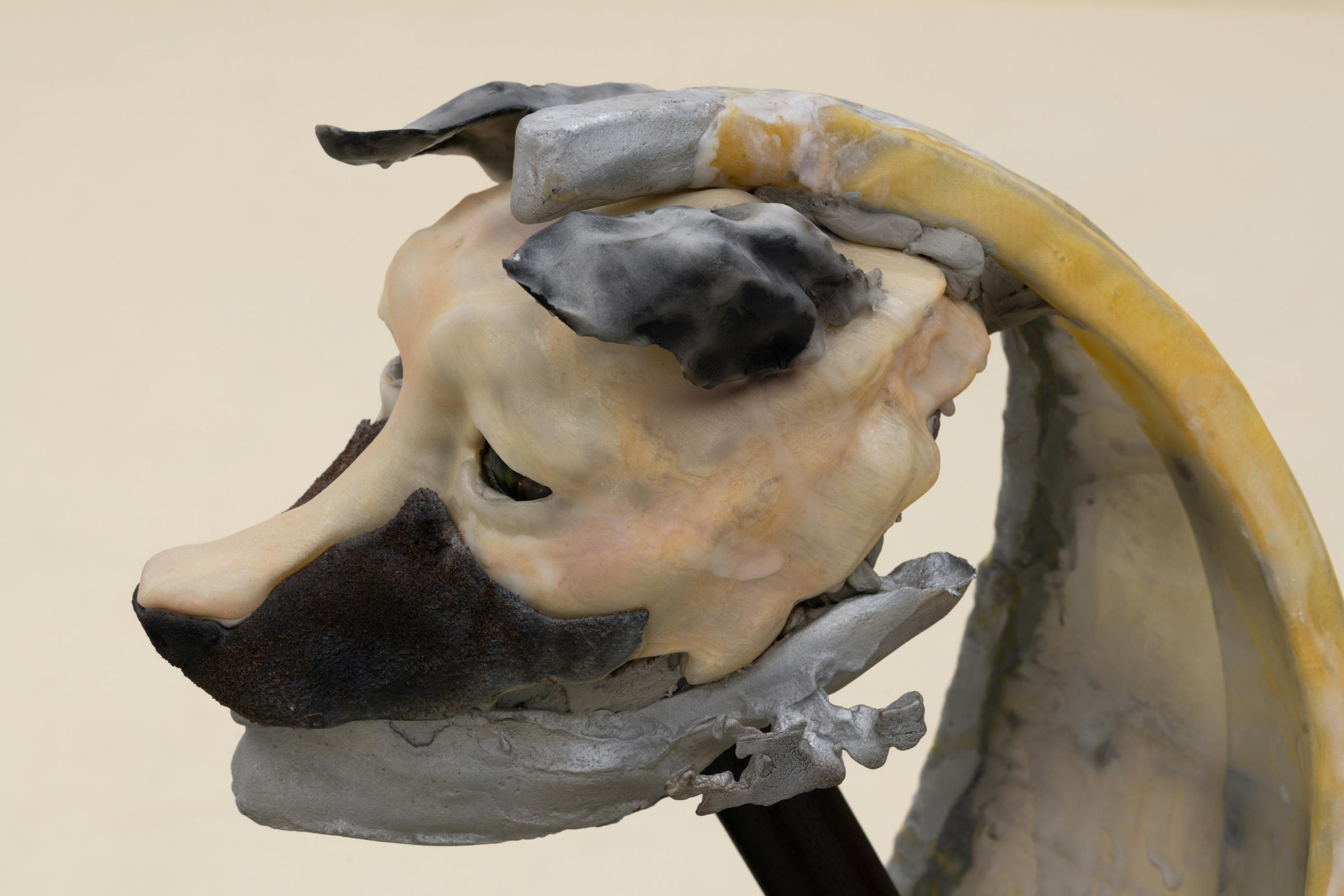
The World Without Us
Coulisse Gallery presents The World Without Us, a duo exhibition of Uchercie and Isaac Lythgoe. The exhibition's title references the disquiet within both artists’ work and a movement past fantasy toward science fiction, which is the art of the possible or the history of ideas that will inevitably become real. [i] In this narrative, material, and color matter, as the industrial anodizes metallic skin, and the posthuman, the hybrids, and the hussies eagerly breed to endure. The artworks contain elements of the past and future, traces of fiction, and forecasts of absence.

Isaac Lythgoe, It’s only a game but it’s the only game, 2024
Epoxy, Fibreglass, Pigments, PET, Telephone parts, Ebonized Oak, Jesmonite, Epoxy Clay, Stainless Steel, Acrylic & Lacquer
80 x 50 x 25 CM
Epoxy, Fibreglass, Pigments, PET, Telephone parts, Ebonized Oak, Jesmonite, Epoxy Clay, Stainless Steel, Acrylic & Lacquer
80 x 50 x 25 CM

UCHERCIE, #24,2024
Oil
46H x 112W CM
Oil
46H x 112W CM

UCHERCIE, #21, 2024
Oil
30H x 20W CM
Oil
30H x 20W CM

Isaac Lythgoe, You only need eyes to see, you only need a tongue to tell the difference, 2024
Epoxy, Fibregalss, pigments, PET, Cast Aluminium, Scarab Beetle, Ebonized Oak, Walnut, Amaranth, Epoxy Clay, Stainless Steel, Acrylic & Lacquer
78 x 50 x 26 CM
Epoxy, Fibregalss, pigments, PET, Cast Aluminium, Scarab Beetle, Ebonized Oak, Walnut, Amaranth, Epoxy Clay, Stainless Steel, Acrylic & Lacquer
78 x 50 x 26 CM

UCHERCIE, #25, 2024
Oil
46 x 112 CM
Oil
46 x 112 CM

UCHERCIE, #26, 2024
Oil
76H x 123W CM
Oil
76H x 123W CM

In a novel bearing the same title, Alan Weisman observes places humans have abandoned—making the “us” the naturally disassociated “us” and the void a rewilding. There’s Chornobyl and a reference to the puszcza, an old Polish word that means “forest primeval.” Weisman observes in these cases the materials that endure, such as plastic, bronze, and radio waves, and recounts that non-functional objects have greater shelf life than the ill-fated functional ones. Systems that need maintenance workers are the first ambitions to crumble. Here, science fiction is real, and the spectacle has no viewers.
Isaac Lythogoe’s gesture towards the fractured and hollowed – offers the remains of an amusement park, arcade, or zoo. There is something of a pageantry that has come to die, and a place of innocence stilted. Lythogoe’s works often reference fairy-tale characters that are simultaneously timeless and terminal, as if their fiberglass shells and automotive features have been eroded by centuries of neglect. Little Red Riding Hood lies in wait, deadpan and demure. A secondary narrative layer to this body of work is “The Moon” by the Brothers Grimm, which recounts how the moon came to be through thievery and a two-pound coin. Lythgoe combines these literary and visual tropes to forge unfamiliar creatures where the moon – a once silent companion to humankind – now looms as a pitiless overseer in an empty world and seems bothered. This is the future decay, where magic has soured, and wonder is left to rot. Lythgoe reminds us, "It’s only a game, but it's the only game,” through the title of one work, and in doing so, rounds out a dark sense of humor and freedom of being in a world that no longer revolves around human stories; giving voice to players that endure in a post-human reality.
Uchercie’s paintings, similarly, question the limit and voids. They portray details of larger, unknown bodies or systems. It's unclear how such colors could exist in the bleakness of a collapsed landscape, and yet Uchercie’s delicate compositions abide. These folds and fractures speak to the bridging between worlds, civilizations, or materials, referencing Uchercie’s other interest in language and narratives of counteraction. Uchercie states their work is complete when its “syntax has a sense of both conflict and harmony.” [ii] This conceptual desire to reach balance is mimicked in the paintings for their formalistic accomplishments in color and light. Shard’s bleed into each other, indistinct and severe. They suggest a dimension where translation is impossible, where our language and constructs are swallowed by a world that no longer needs them. Fight, flight, fawn, and freeze remain the basis of stress responses to danger. All four-claim territories in the work, reflect a post-capitalist-post-human edging and disturbing hypotheses of Dark Forest Theory.
Thus, between this figure and abstraction, perhaps one acknowledges that the world without us is not a world that remembers. Rather, it is a world that endures, rolling over what’s left, absorbing scars and sacrificial lambs like hiccups, allowing the othered to emerge, unafraid of the ego or the anthropocentric. The World Without Us is a landscape shedding the language and bad habits left upon it. In the absence is movement, character, and art. Such is the science and the fiction.
Text by Nathallie Viruly